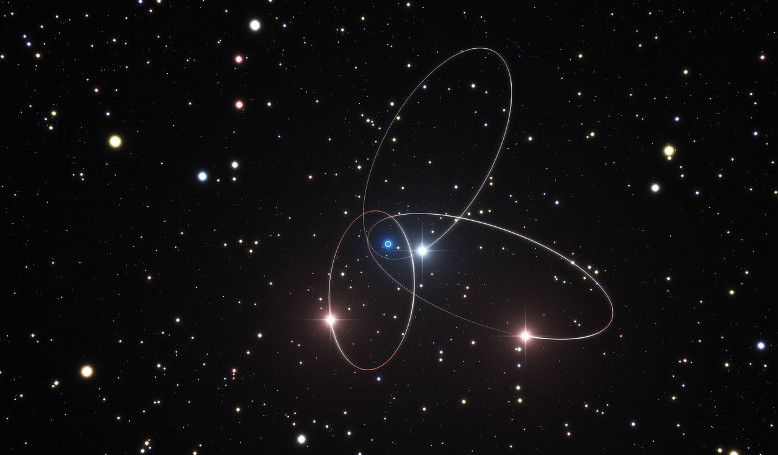Astronomers studying S2, one of the closest stars to the supermassive black hole at the centre of our galaxy, say that the star may show the subtle effects predicted by Einstein’s general theory of relativity. If confirmed, this would be the first time that the strength of the general relativistic effects have been measured for stars orbiting at high speed in the gravitational field near Sgr A*.
As far as stars go, S2 might seem quite innocuous – its not one that regularly hits the headlines. However since 1995, this star, known as an S-star, has been providing scientists with information that has led to the confirmation that a supermassive black hole (SMBH) with a mass four million times that of the Sun and located 26 000 light-years from Earth, resides at the centre of our Milky Way.
Although the existence of Sagittarius A* (or Sgr A* for short) was inferred much earlier, it is these details – its mass and distance – that have been inferred from the study of S-stars; a small group of fast-moving stellar companions that orbit the supermassive black hole’s very strong gravitational field – an environment that is also perfect for testing gravitational physics, especially Einstein’s general theory of relativity.
Now, with the help of S2 again and observations from ESO’s Very Large Telescope (VLT), a team of German and Czech astronomers have found suggestions that a small change in the motion of S2 is consistent with the predictions of general relativity.
To determine these effects, the team had to know the star’s full orbit to very high precision, and they achieved this by comparing its measured orbit to predictions made using classical Newtonian gravity along with predictions from general relativity.
Using a new analytic technique, the team were able to infer that the change in S2’s orbit due to relativistic effects amounts to only a few percent in the shape of the orbit, as well as only about one sixth of a degree in the orientation of the orbit. Nonetheless, these are the first measurements of this type to be made for stars orbiting a supermassive black hole.
"The Galactic Centre really is the best laboratory to study the motion of stars in a relativistic environment. I was amazed how well we could apply the methods we developed with simulated stars to the high-precision data for the innermost high-velocity stars close to the supermassive black hole,” said Marzieh Parsa, PhD student at the University of Cologne, Germany and lead author of the recently published research paper detailing these results.
This tantalising result sets the scene nicely for further tests that will be conducted with the GRAVITY instrument as S2 passes very close to the black hole in 2018. GRAVITY, which is installed on the VLT, will not only be able to measure distances in the sky to very high accuracy but it will also be be able to observe very small details on faint objects like the centres of galaxies with its high sensitivity performance.
GRAVITY is already making high-precision measurements of the Galactic Centre and it is expected to soon reveal general relativistic effects very clearly. It will also allow astronomers to look for deviations from general relativity that in the process, might reveal new physics. “This opens up an avenue for more theory and experiments in this sector of science,” said co-author Vladimir Karas from the Academy of Sciences in Prague, the Czech Republic and a fellow author on the paper.











